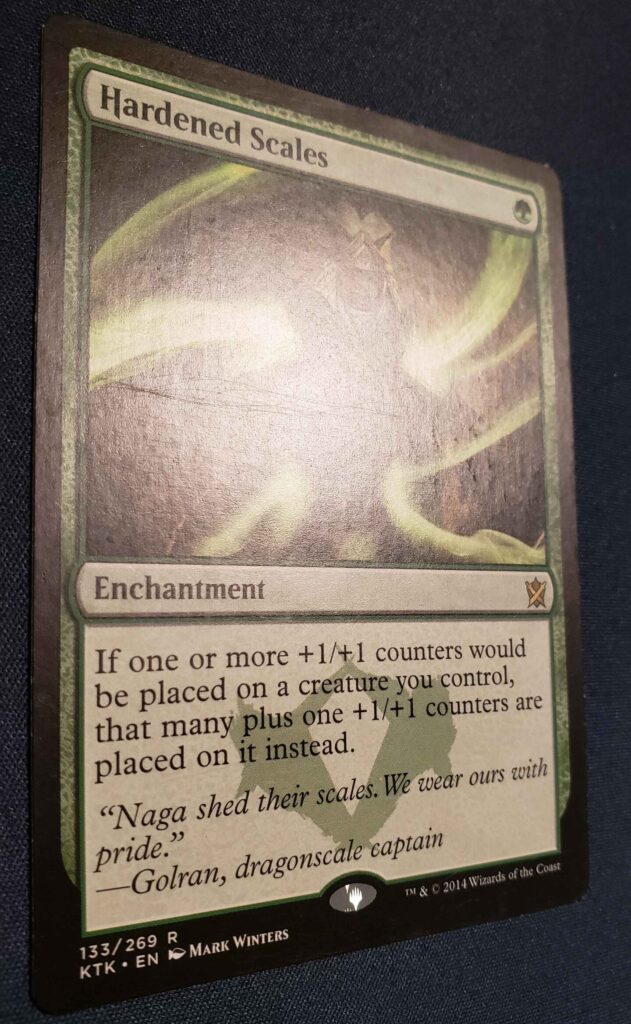How to Use the Cardsphere Condition Guide

(Corpse Appraiser | Art by Josh Hass)
Comprehending Card Conditions
Friendly greetings, and welcome to Tricks of the Trade, an series about improving your Cardsphere experience. I'm John Sherwood, your fellow card trader and Magic player. In this issue, we're taking an in-depth look at our Card Condition Guide and applying it to the cards we send and receive.
If you've spent any amount of time in trading card social media circles, you've probably seen the posts of "Near Mint" cards received in obviously degraded condition. These stories often accompany calls to boycott a specific vendor, or pleas for help getting money back from an unscrupulous seller. Cardsphere is not immune to misrepresented cards, but we are dedicated to preventing conflicts and resolving disputes as they arise. This article has two purposes: first, to help you list your Haves in the correct condition; second, to encourage you to accurately evaluate cards you receive so you can submit a valid dispute if necessary.
"Scarcely a mark. A true work of art!"
Corpse Appraiser could probably teach us a thing or two about assessing merchandise. Since we're all armature appraisers, the Cardsphere Card Condition Guide exists to help all of us apply the same standards to our cards. It's an art, not a science, and the first step to practicing the art is to read the guide. The full link is below, in case you didn't click one of the other links I already imbedded in this article.
https://www.cardsphere.com/condition-guide
Please read the guide. Better yet, open it in another tab and follow along through the rest of this article. Now that we're all looking at the same pages, we'll discuss each of the the possible conditions in detail. As we explore card conditions together, please keep in mind that Cardsphere's Condition Guide is not for grading cards. We're not a professional service for grading collectibles, we're a community of Magic: the Gathering hobbyists helping each other exchange cards in a fair and economical manner.
Near Mint (NM)
Cards in near mint condition show insignificant or no wear from gentle play, and are BARELY DISTINGUISHABLE FROM UNDAMAGED CARDS right out of a pack. [emphasis added]
The condition of a truly NM card should be penny sleeve clear. A casual observer would assume a NM card is freshly cracked. A practiced observer might not see a problem on a NM card unless they are actively looking for it. The standards for assigning NM condition to a card are the most strict in the Condition Guide. A Near Mint card is allowed only one flaw, and that one allowed flaw should be, in a word, insignificant.
Frequent handling and improper storage cause obvious degradations to a card's faces and edges, and none of those obvious flaws are present on a near mint card. If you want to keep new cards in near mint condition, try the storage tips from my last article.
If you've ever opened a pack of cards, then you know what an unblemished card should look like. From that frame of reference, you can consider the Condition Guide's list of characteristics for near mint cards. Go ahead, look at that other tab we opened. The phrase, "very minor" appears five times in quick succession. The intent should be very clear: your near mint card might have one tiny flaw, and that's okay.
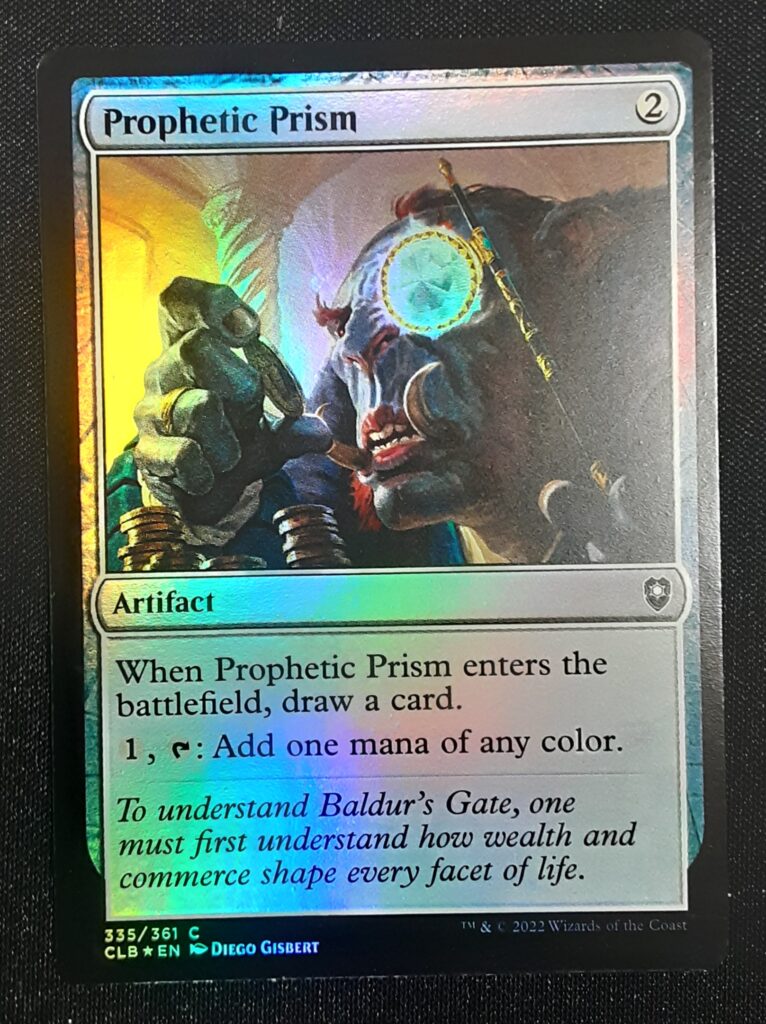 This near mint foil Prophetic Prism is fresh out of pack.
This near mint foil Prophetic Prism is fresh out of pack.
When you mark a card as Near Mint in your Cardsphere Haves, be honest with yourself and your Cardsphere peers. The 10% price difference between Near Mint and Slightly Played isn't worth lying for. When you receive a near mint card from another Cardsphere user, give the card a quick glance for anything obvious before you start an in-depth analysis. Whether you're sending or receiving, keep that new card look and feel in mind, but don't over-scrutinize. The "near" in near mint means we all accept that these cards and our Cardsphere community are not perfect.
Slightly Played (SP)
Cards in slightly played condition show minor wear from typical play, but are clearly distinguishable from undamaged cards right out of a pack.
Criteria for slightly played cards include adjectives like slight and minor, because these cards are still in great playable and tradable condition. Cardsphere marks SP cards down to 90% of index because they are almost as good as NM. That being said, the SP category includes a few criteria not present on NM Cards: minor curling, very minor binder denting, slight scratching. If a card has any of those defects, it's not NM, and it could be SP.
A SP card is permitted two of the flaws from the list in the Card Condition Guide. Take this copy of Hardened Scales for example:
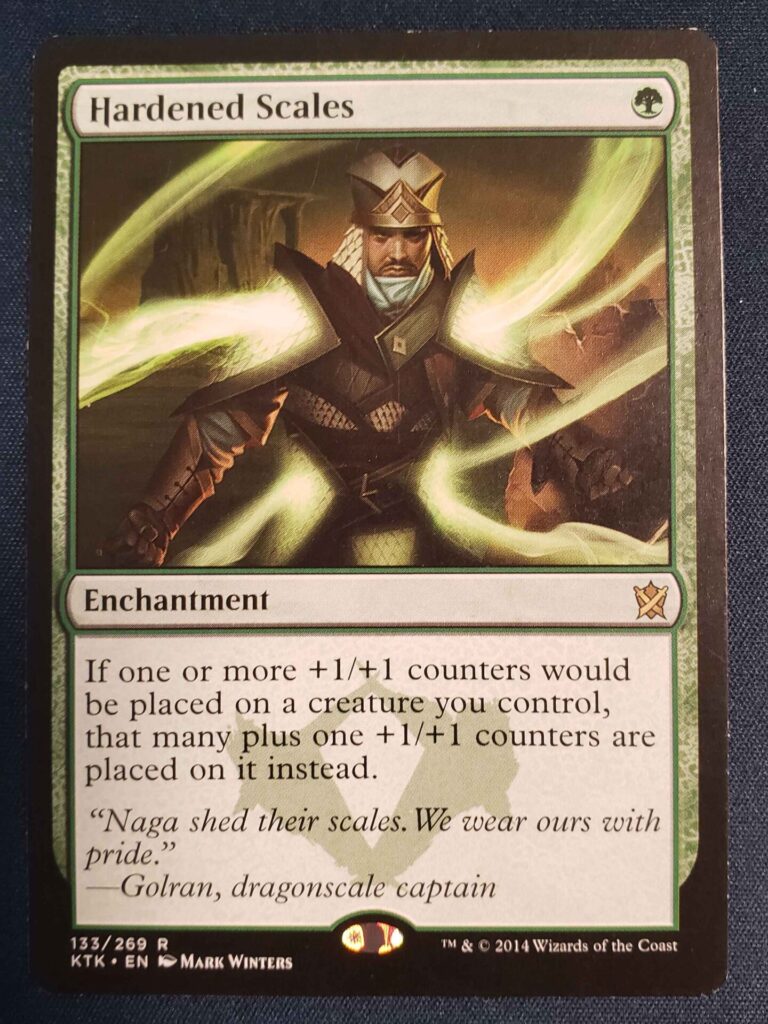 Slightly played Hardened Scales
Slightly played Hardened Scales
In my opinion, the border wear on this copy of Hardened Scales is minor. The white dots around the edges of the card are tiny and spread out. Despite my 20/20 vision, this card has another defect that I can't see from this angle, so here's another picture:
Minor scratching is visible under glare from my camera flash.
Slight scratching is visible over the art. Even in my brightly lit dining room, I had to use my camera flash for the scratching to be visible in the picture. When I'm holding this card in person, the scratches are not visible from most angles. That seems slight to me, but I know it would bother some people. That's one reason it's so important to be honest with ourselves as Cardsphere members when we list our haves. We want to avoid disputes. But more than that, we want other users to be happy to trade with us again.
Remember that new card look and feel? Slightly played cards don't have it, and that's okay. SP cards are good value for your money, and very much sleeve playable.
Moderately Played (MP)
Cards in moderately played condition show obvious wear from typical play and are easily distinguishable from undamaged cards right out of a pack.
Are you playing Magic on a budget? I am, and I love MP cards. Cardsphere automatically prices MP cards at 75% of index. These cards are far from perfect conditon, but they are alse still perfectly legible and legal. Factoring in the ability to negotiate prices with other Cardsphere users, MP cards are in a sweet spot for budget players.
Identifying an MP card is a bit nebulous. If MP was a number in the absurd Commander Power Level discussion, then it would be the meme-tastic seven. As before, the basis for comparison is a card fresh out of a pack. For finer details, the MP level of the Condition Guide lists a broad mix of definitive and subjective descriptors. MP cards are allowed to have up to three traits from the list.
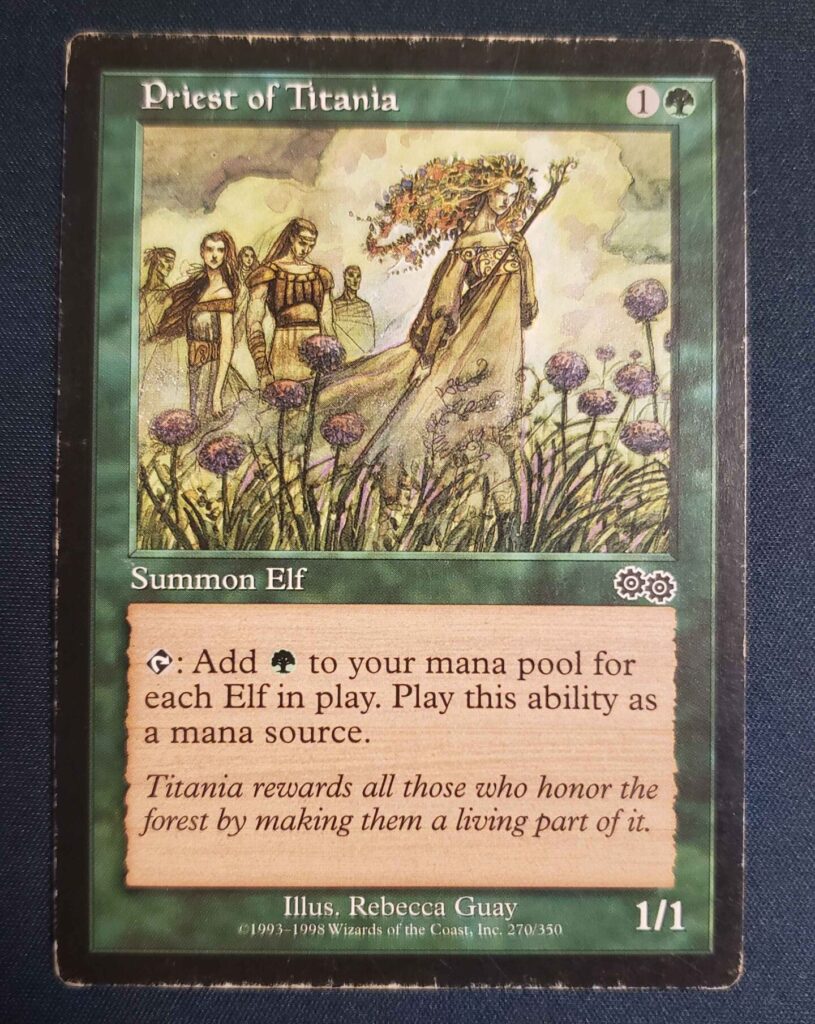 My moderately played Priest of Titania is perfect just the way she is.
My moderately played Priest of Titania is perfect just the way she is.
Look at this gem! Obviously loss of sheen is is a factor for a card printed in 1998. Meanwhile, there is some border wear all the way around; this card was probably played unsleeved. Fortunately, I don't see any other notable flaws. There's probably a case to be made that this card is heavily played, but I bought it as MP and I'm not mad. My Priest of Titania is in fabulous shape for a piece of cardstock old enough to rent a car. Someone else enjoyed this beauty, then sold it cheap so I could enjoy it too. I bought this copy before Priest of Titania got reprinted in The List. At the time, the price for near mint was too rich for my spare change Magic budget. I play it in my Tyvar the Bellicose Commander deck, and you'll never see it my Haves on Cardsphere. Get your own.
Heavily Played (HP)
Cards in heavily played condition show significant wear from typical play and are very easily distinguishable from undamaged cards right out of a pack.
As we move down the scale of card conditions, the attributes begin to be solidify again. Similar to MP cards, HP cards are allowed three factors from the list of criteria. However, the flaws on a HP Card are significant, contrasting directly against insignificant for near mint. Notably, HP cards are not outright damaged, but still degraded enough to warrant a markdown to 60% of index price.
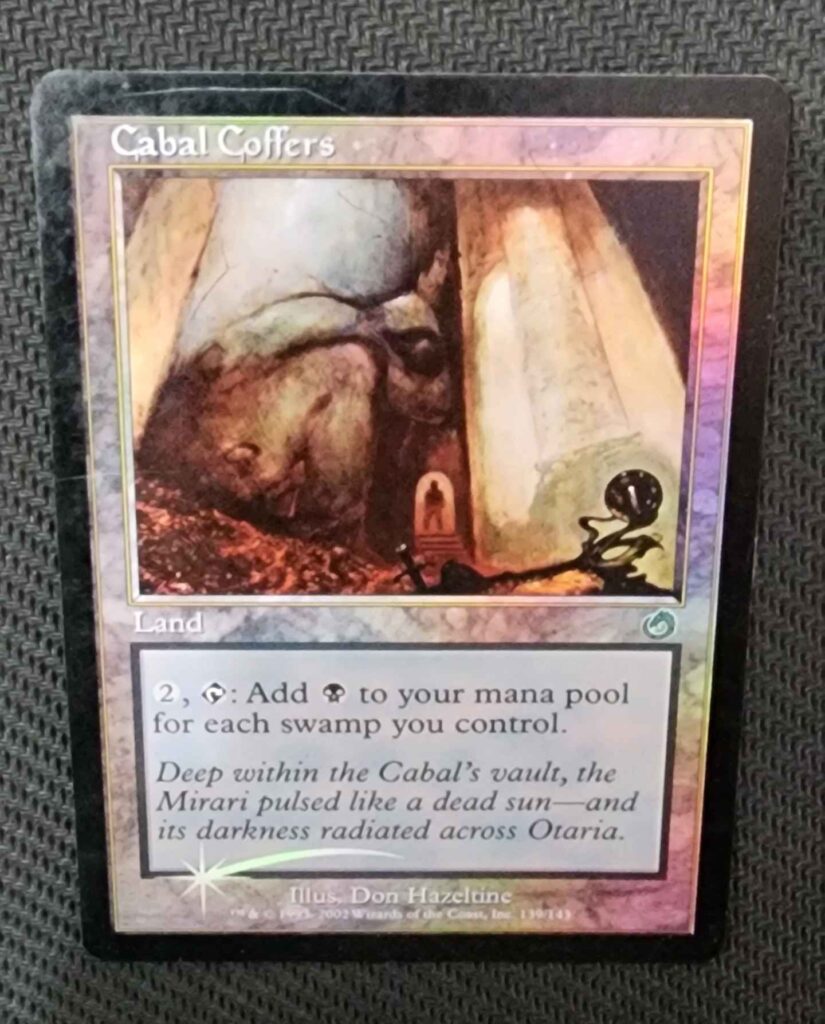 Cabal Coffers image courtesy of Nick Wolf.
Cabal Coffers image courtesy of Nick Wolf.
Commander's Herald contributor Nick Wolf provided the image of this foil Cabal Coffers. We ran a Card Condition poll for this card on the Cardsphere Discord Server, which is one of the tools Cardsphere admins use to resolve user disputes. As you can see in the results of the poll, the community was closely split between MP and HP for this card. We'll get into the details of disputes and condition polls later, but right now we're going to break down the results of our Cabal Coffers poll.
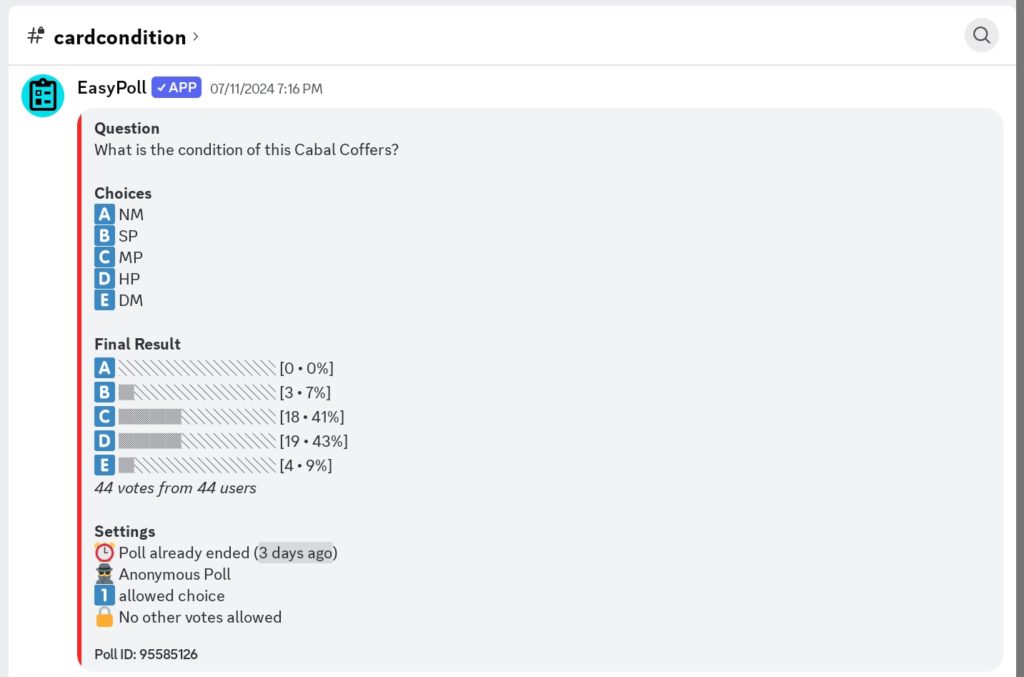 Card Condition Poll for Nick's Cabal Coffers
Card Condition Poll for Nick's Cabal Coffers
As you can see in the results of the poll, the community narrowly voted HP over MP for Nick's card. Part of the reason I'm highlighting this specific example is to emphasize that card conditions are very subjective and there is not always an exact right answer. A near equal number of users voted MP for this card. The top left corner of the card displays foil clouding and a scratch, permissible to some extent under both MP and HP criteria. Based on my interpretation of the Condition Guide, I believe this is significant scratching and significant clouding.
We highly recommend sending pictures of HP cards to potential buyers to avoid disputes, and many Cardsphere users request this courtesy in their profile notes.
Not Tradeable (NT)
You may not trade cards with any of the following flaws without prior consent of your trading partner who has seen a current scan of the card's condition.
Cardsphere regards all cards with flaws from the Not Tradeable list as damaged. If you send cards in this condition without the buyer's consent, you will find yourself on Santa Cardsphere's NaughTy List. If a dispute arises for violations of this policy, then our admins will side with the buyer. Damaged cards have flaws that do not appear in any other condition, and the standard is strict. Any one of these flaws denotes a damaged card.
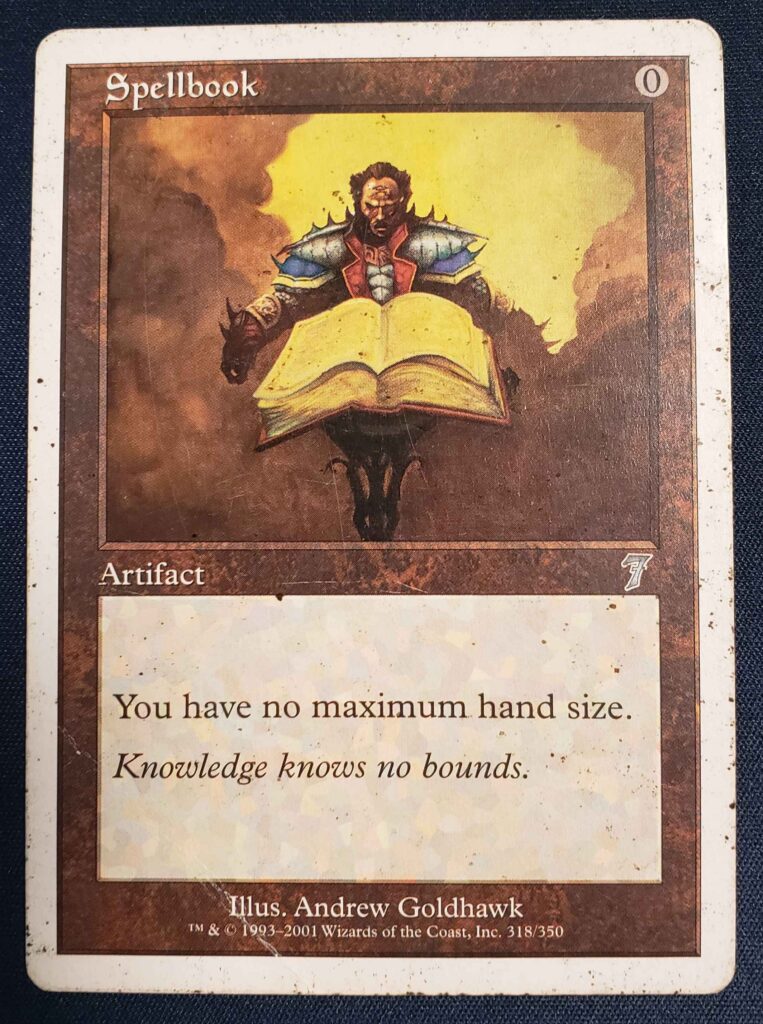 This Spellbook is clearly damaged.
This Spellbook is clearly damaged.
My Seventh Edition Spellbook is a perfect example of a damaged card. At some point in this card's life it suffered an edge to edge crease across the bottom-left corner. That kind of paper damage doesn't buff out. This example also has markings on the card face. I don't know what those black speckles are, but they don't come off. Despite this card's NT condition, it is still sleeve-playable and it's been in and out of multiple decks since I acquired it a few years ago.
One of the the more common requests we get from the community is support for signed cards. We understand there is a market for autographs from artists, designers, and content creators. Unfortunately the reasons we don't support them far outweigh the potential benefits. You are welcome to arrange private trades for signed and damaged cards through Cardsphere, but never without prior consent of your trading partner who has seen a current scan of the card's condition.
Disputes
About 2% of trades on Cardsphere result in condition disputes. We encourage users to communicate with their trade partners first, but the Cardsphere admins are here to help. You can read more about disputes in these Cardsphere resources:
- Cardsphere FAQ: When Should I open a dispute?
- Disputes 101
- Disputes 102
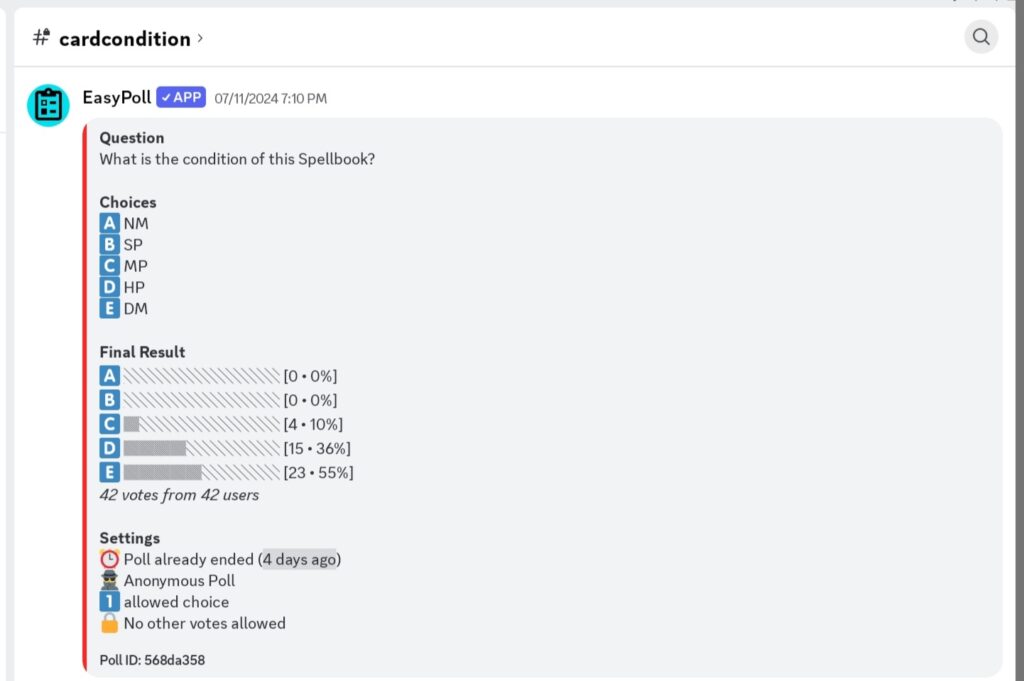 Spellbook Condition Poll
Spellbook Condition Poll
We ran a poll on my copy of Spellbook, and the results are interesting. I'm honestly surprised nineteen people gave this card a condition other than damaged. Again, people don't always evaluate cards the same way. This is the reason Cardsphere admins sometimes use condition polls to ask for more eyes and opinions. The polls are not binding; we retain the final word on disputes, but we value and appreciate community participation when we decide a poll is warranted.
Cardsphere users are smart and perceptive; don't think you can make a habit of cheating people on card conditions. Be honest with yourself about the condition of your own Haves. If you find yourself rationalizing a defect, then there's a good chance you'll lose in a dispute with a buyer. As a buyer, be reasonably flexible with the cards you receive, but don't let people take advantage of you either. Here are a few suggestions for preventing and resolving disputes:
- Compare cards side-by-side with a new card. Remember, the Condition Guide is based on comparison to a card fresh out of a pack.
- Look at past polls in Cardsphere's Discord for images with similar conditions. The history is there for you to reference, even after the polls are closed.
- Ask a neutral third party for a second opinion, but please show them the card without any coaching or suggestions to skew their perception.
Happy Trading
Hopefully this article helps you have a better trading experience on Cardsphere. We want to help you be the kind of trade partner your peers will recommend and return to. If you disagree with my examples, or have some other tips for evaluating card condition, please share in the comments. You can also join the conversation on Cardsphere's public Discord channel. It's a great community of people like you. Special thanks to Efren Abrego, who ran the polls and always answers my questions. Also thanks to Nick Wolf and the Cardsphere Discord community for their contributions to this article. Until next time, happy trading.

